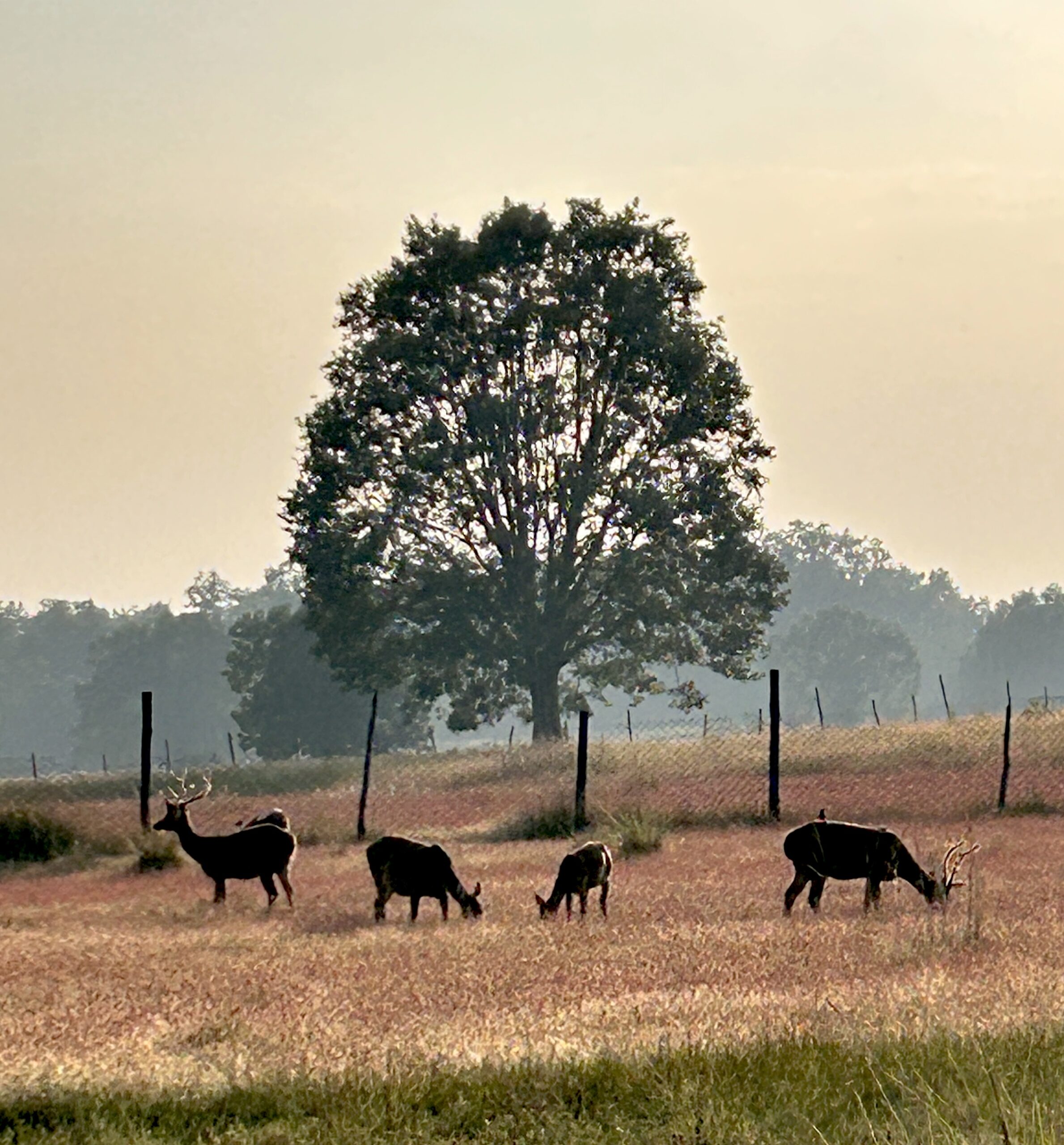It’s a place where meadows shimmer with dew, sal trees touch the sky with silence, and the forest still keeps time by the rhythm of hoofbeats and birdsong. I’ve walked those roads, sometimes dusty, sometimes golden with light, and every time, Kanha has offered something new.
This is the practical guide I wish I’d had before my first safari — simple, grounded, and shaped by experience. It doesn’t mean that you don’t need a guide – please get one, you will learn 100% more than DIY.
Getting There: The Journey Matters
Kanha lies deep within the Mandla and Balaghat districts of Madhya Pradesh, nestled among the Maikal range of the Satpura Hills.
It’s one of those rare journeys where the drive itself becomes part of the adventure.
- By Air: The nearest airports are Jabalpur (160 km), Raipur (250 km), and Nagpur (300 km).
Jabalpur and Raipur works best for most travellers — good roads, scenic forest stretches, and excellent connections. - By Train: The closest stations are Gondia (145 km) and Jabalpur (160 km).
- By Road: Expect 4–6 hours from any major city. The route weaves through villages, fields, and glimpses of forest that hint at what’s waiting ahead. Check on which gate you need to arrive at. Mistakes here can cost you in time and expense.
🛣️ Author’s note: I always stop for chai in Mandla — that’s where the journey shifts from ordinary to wild.
Each season in Kanha has its own story — and its own colours.
- October–November: The park reopens fresh from the monsoon, green and alive. Perfect for photographers and first-timers.
- December–February: Crisp mornings, misty meadows, and migratory birds. Pack warmly for early drives.
- April–June: The height of tiger season. The forest thins, waterholes shrink, and life gathers around them. Expect heat, dust, and unforgettable moments.
The park closes every year from 1 July to 15 October — a vital rest for the land and its inhabitants.
☕ If you enjoy quieter travel, aim for November or March. You’ll meet fewer people and hear more of the forest’s true voice.
Understanding the Permit System at Kanha
Planning a Kanha safari is easier once you understand how it works. Between permits, guides and safari jeeps it can get confusing.
While your accommodation may be able to help you with the jeep hire, you can also hire jeeps (and drivers) from the National Park Gate. There is also a “Bus” that accommodates travellers from the MP State lodge, and others. But you have to line up quick for anything that you haven’t booked earlier.
You may or may not get a permit for the day as quantities are very restricted. For a reason.
Safaris must be booked online via the MPOnline portal.
- Booking opens 120 days in advance at 11 AM each day.
- You’ll pay first for the permit, and then separately for your vehicle and guide at the gate.
💰 Approximate costs:
- Shared Jeep Safari: ₹600–₹800 per person
- Private Jeep (6 people): ₹6,500–₹8,000 total
- Each permit covers one jeep (up to 6 people).
- The permit fee is paid online, but the guide and jeep fees (₹6,500–₹8,000 total) are paid at the gate.
- If you’re solo or a couple, shared safaris cost around ₹600–₹800 per person and are often more sociable.
Always carry your ID, and arrive early—gate formalities take time.
Note: Safari charges are higher for those with a foreign passport.
Choosing Your Zone
Kanha is divided into four core zones:
- Kanha Zone: Classic grasslands and prime tiger country.
- Kisli Zone: Lush forest drives, also strong for sightings.
- Mukki Zone: Peaceful and scenic, with great herbivore action.
- Sarhi Zone: Lesser-known, rewarding for birders and solitude seekers.
If it’s your first time — start with Kanha or Kisli.
Avoid Wednesday afternoons, the park is closed to visitors.
Where to Stay: Lodges and Local Charm
The park’s magic doesn’t end at the gate — your stay is part of the experience.
Here are three styles to choose from:
- Eco-lodges: Thoughtful design, sustainability, and silence.
Examples: Banjaar Tola (Taj Safari), Kanha Earth Lodge, Shergarh (we stayed here) - Comfort Resorts: Reliable, comfortable, family-friendly.
Examples: Mogli Resort, MPT Resort. - Homestays: Around Khatia and Mukki — authentic, simple, often run by families who know the forest as home.
✨ Author’s Tip: Choose a lodge where you can step outside and see stars. In Kanha, darkness is still real — and the night sky feels ancient.
What to Pack: Keep It Simple, Keep It Quiet
Your suitcase should whisper, not shout.
- Colours: Neutral — khaki, brown, olive, beige.
- Winter: Jacket, gloves, muffler, cap.
- Summer: Light cotton, hat, sunscreen, scarf.
- Essentials: Binoculars, camera, water bottle, insect repellent, and a small torch.
- Nice-to-have: Notebook, shawl, patience.
Leave behind anything that smells strong, shines brightly, or plays music.
The forest prefers modest company.
In the Jeep: How to See More by Doing Less
Safaris reward those who watch and wait.
Your guide will know the calls — the bark of the langur, the alarm cry of the spotted deer, the whisper of movement in the grass.
- Stay seated and silent. Movement breaks the moment.
- Look and listen. Don’t just chase the tiger — watch the small life that thrives around you.
- Be ready. A glimpse lasts seconds, but the memory can stay for years.
If you don’t see a tiger, remember: it saw you.
And it chose to remain unseen.
Beyond the Safari: The Slow Kanha
Leave one afternoon unscheduled.
Sit outside your lodge, listen to birds, write a page.
Visit a local village — many artisans carve wooden deer or paint forest scenes, part of Kanha’s community tourism program.
Meet the naturalists. They carry stories of Barasingha rescues, legendary tigers like Umarpani, and their own quiet triumphs.
What Kanha Teaches
By your second dawn, you start to feel it — the rhythm.
Alarm calls fade with sunrise, birds settle, the forest exhales.
Kanha doesn’t rush. It asks you to slow down enough to belong.
“The forest was very still, for the beasts knew that something was abroad,” Kipling wrote.
In Kanha, that stillness still exists — ancient, patient, watchful.
You go looking for tigers. But you leave remembering the living stillness.
Quick Reference
- Best time: October–June (closed July–mid-October).
- Gates: Khatia (main), Mukki (quiet), Sarhi (remote).
- Zones: Kanha, Kisli, Mukki, Sarhi.
- Safari times: Early morning & afternoon.
- Bookings: forest.mponline.gov.in
- Airports: Jabalpur, Raipur, Nagpur.
- Cost: ₹6,500–₹8,000 per private vehicle
For Writers Who Need to Disappear (and write)
I’m planning a writing retreat here. Limited spots. No workshops, no forced sharing circles, no mandatory “creative exercises.” Just protected time, this space, and the permission to finally do the deep work you’ve been postponing. Or maybe a workshop or two. Or Art.
What you get:
- A tented luxury room
- Mornings of productive creativity
- The kind of quiet that lets you hear yourself think , or ink
- Optional evening discussions about craft—only if you want them
- A location I’m not posting publicly (you’ll get exact details when you commit)
- The accountability of other creators doing the same work
What you don’t get:
- WiFi strong enough to doomscroll (it’s there, it’s just weak enough to keep you honest)
- Distractions disguised as networking
- Excuses for why you didn’t finish that project
Who this is for:
- Writers finishing manuscripts, essays, or content series
- Creators who need to batch content without the usual interruptions
- Anyone who’s tired of “writing retreats” that are actually just expensive vacations with laptops
- People who understand that sometimes the best thing you can do for your work is get out of your own environment
Interested? The lane doesn’t appear on most maps. And I’m keeping it that way.
Contact me directly for retreat dates, pricing, and the exact location. Limited to 8 writers per session.
Because the question isn’t whether you need this kind of space. The question is: are you willing to look the tiger in the eye?











